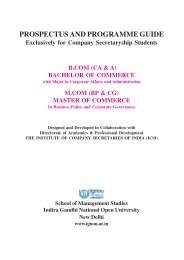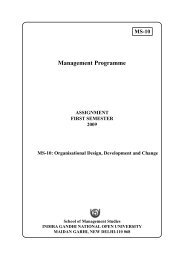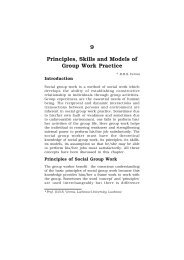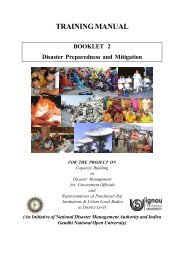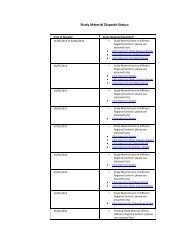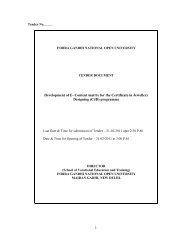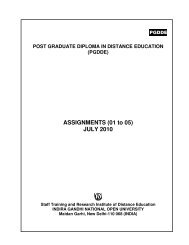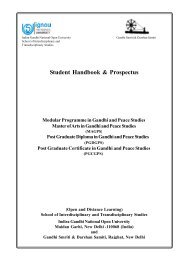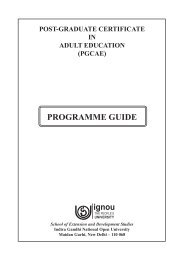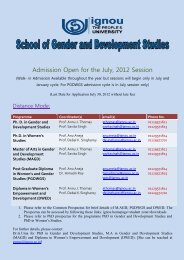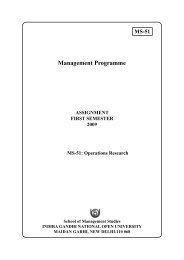Disaster Recovery and the Road Ahead - IGNOU
Disaster Recovery and the Road Ahead - IGNOU
Disaster Recovery and the Road Ahead - IGNOU
You also want an ePaper? Increase the reach of your titles
YUMPU automatically turns print PDFs into web optimized ePapers that Google loves.
FOREWORD<br />
Accelerated pace of development brings with it <strong>the</strong> perils of unsafe living, pressures on non-renewable<br />
resources, densely populated spaces <strong>and</strong> environmental degradation among o<strong>the</strong>rs. As a consequence,<br />
<strong>the</strong> frequency of catastrophes such as earthquakes, floods, cyclones, l<strong>and</strong>slides, droughts, <strong>and</strong> fires has<br />
gone up. We hear of disasters so often that we as individuals are sadly becoming immune to <strong>the</strong>m. We<br />
display concern <strong>and</strong> anxiety when <strong>the</strong>se calamities happen, but by <strong>and</strong> large depend on <strong>the</strong> concerned<br />
stakeholders to do <strong>the</strong> needful, who on <strong>the</strong> o<strong>the</strong>r h<strong>and</strong>, have a reactive ra<strong>the</strong>r than pro-active approach<br />
to disasters. Stitching up of loose ends takes place after an event <strong>and</strong> <strong>the</strong>n because of lack of follow-up<br />
in terms of reconstruction <strong>and</strong> rehabilitation, <strong>the</strong> affected areas are rendered fur<strong>the</strong>r vulnerable to such<br />
events that keep happening, leading to enormous loss of human resources in particular.<br />
Making disaster management more effective <strong>and</strong> efficient, against this backdrop, is not just a pressing<br />
concern, but an overarching problem facing <strong>the</strong> stakeholders in disaster management. Many efforts in<br />
<strong>the</strong> past, both governmental <strong>and</strong> non-governmental, have been initiated in this direction. Many committees,<br />
forums <strong>and</strong> organizations, both national <strong>and</strong> international, have reiterated <strong>the</strong> pressing need of managing<br />
disasters. There is no dearth of material in <strong>the</strong> form of reports, books, articles <strong>and</strong> manuals on <strong>the</strong><br />
subject. From relief <strong>and</strong> response to preparedness <strong>and</strong> long-term recovery, all major facets of disaster<br />
management have been examined at length. Yet, <strong>the</strong> need to revisit <strong>the</strong> issue is still pertinent, as it opens<br />
up fresh avenues of analyzing its different aspects. This Manual tries to focus on <strong>the</strong> knowledge, skill<br />
<strong>and</strong> attitude inculcation on <strong>the</strong> various facets of disaster management in a novel manner. It emphasizes<br />
<strong>the</strong> role <strong>and</strong> relevance of governmental functionaries <strong>and</strong> representatives at <strong>the</strong> grassroots level, <strong>and</strong><br />
reiterates <strong>the</strong> need for community underst<strong>and</strong>ing <strong>and</strong> participation in <strong>the</strong> disaster management process.<br />
The interconnection between disasters <strong>and</strong> development seems to be <strong>the</strong> core concern of <strong>the</strong> Manual.<br />
This Manual, which is an integral part of <strong>the</strong> Project on ‘Capacity Building for Government Officials<br />
<strong>and</strong> Representatives of Panchayati Raj Institutions <strong>and</strong> Urban Local Bodies at District Level’, addresses<br />
<strong>the</strong> concern of empowering <strong>the</strong> officials <strong>and</strong> functionaries at <strong>the</strong> grassroots level. These are <strong>the</strong> people<br />
who are in constant touch with <strong>the</strong> community. When <strong>the</strong> disaster strikes <strong>the</strong>y are <strong>the</strong> immediate responders<br />
along with <strong>the</strong> community to go to <strong>the</strong> site with relief. Their training in disaster management is <strong>the</strong> best<br />
example of preparedness needed for disaster management in <strong>the</strong> country. Having myself worked in <strong>the</strong><br />
area of capacity building of PRIs for over two decades <strong>and</strong> being deeply involved in Rural Development<br />
interventions both at national <strong>and</strong> international levels, I am convinced that this Manual will be able to live<br />
up to <strong>the</strong> expectations of <strong>the</strong> participants. I am confident that it would be of substance <strong>and</strong> value to <strong>the</strong><br />
grassroots level officials <strong>and</strong> functionaries, <strong>and</strong> all those interested in <strong>the</strong> area of disaster management.<br />
(Professor. M. Aslam)<br />
Vice-Chancellor <strong>IGNOU</strong>



